Welcome to Kenmore Scotland
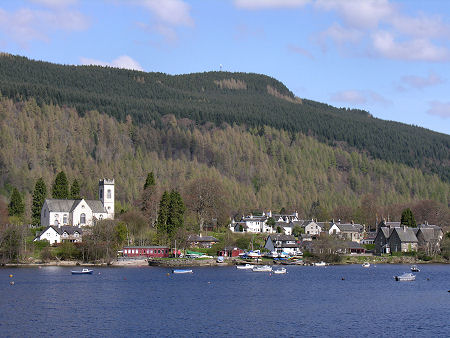 Kenmore
is an extremely attractive planned village situated some 6 miles west
of Aberfeldy on the A827. Its site is on what amounts to a promontory
projecting into the eastern end of Loch Tay, and it has the loch to its
south and west, and the River Tay to its north. Kenmore
is an extremely attractive planned village situated some 6 miles west
of Aberfeldy on the A827. Its site is on what amounts to a promontory
projecting into the eastern end of Loch Tay, and it has the loch to its
south and west, and the River Tay to its north.
Kenmore as you see it today was built as a planned estate village by the
Earl of Breadalbane in the years following 1755. It stood on the site
of an earlier village which in medieval times may have been known as Inchadnie.
Another account suggests that Inchadnie was actually a distinct village
which until 1550 stood beside a ford over the River Tay a little to the
east. It was then removed to make way for the construction of the principle
seat of the Campbells of Breadalbane, Balloch Castle, the predecessor
of Taymouth Castle.
Accommodation in and around Kenmore
Price Guide - per person based on sharing room:  under $40 -
under $40 -  $41
- 70 - $41
- 70 -  more than
$70 more than
$70
At the heart of Kenmore is "The Square", an extremely broad
east west street lined with strikingly attractive (mainly) white harled
buildings. The most imposing of these is the Kenmore Hotel, on the north
side of the Square. This claims to be Scotland's oldest inn and carries
a date of 1572. On one of the walls is a poem written, actually onto the
plaster of the wall itself, by Robert Burns during a visit in 1787. The
Kenmore Hotel oozes character with distinctive rooms and a striking front
entrance supported by black painted tree trunks. At the end of the row
of cottages on the opposite side is the village shop and post office.
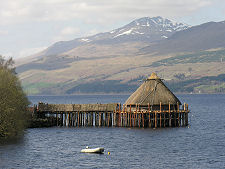
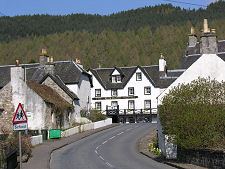
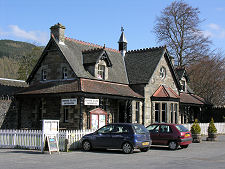
The parish church built to serve Kenmore in 1760 reused parts of an earlier
church built in 1669. It stands at the west end of The Square on a site
that drops steeply on two sides to Loch Tay. Another feature that was
important to the success of the newly redeveloped village was the construction
in 1774 of the seven arch Kenmore Bridge, built across the River Tay immediately
to the north west of the village, where the river flows out of Loch Tay.
It is said that £1000 towards the cost of its building was donated
by George III.
The main road through the village uses the western two thirds of The
Square before turning south to run along the east end of Loch Tay. The
quieter eastern end of The Square is home to the village information centre
and is dominated by the elaborate stone gateway leading to the estate
of Taymouth Castle. Much of the estate is now a golf course. Taymouth
Castle itself is vast and imposing. It was built between 1802 and 1842
on the site of the earlier Balloch Castle and is said to contain some
of the most opulent interiors from the era anywhere in the UK.
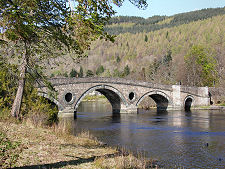
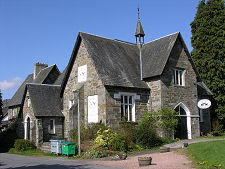

Taymouth Castle passed through a variety of uses during the 1900s. In
more recent times work has been undertaken as part of a £74m project
to convert it into the UK's first 7 Star hotel, but while this has at
least ensure the castle is watertight, work has been sporadic and the
future of this magnificent building seems unclear.
Kenmore makes much of its waterside location. Piers and moorings line
the side of the loch to the south of the centre of the village. Meanwhile
the village has extended to the north, to the far side of the River Tay,
where attractive new development has appeared in recent years.
For those more interested in the hills than the lochs, Kenmore is superbly
located, offering convenient access to Glen Lyon, to the hills of Breadalbane
and, north, to Schiehallion and beyond. Readily visible from the lochside
at Kenmore is Ben Lawers, towering over the north side of Loch Tay, and
falling only marginally short of the magic 4000ft mark.
Just out of the village along the south Loch Tay road, is the Scottish
Crannog Centre. The key exhibit is an authentic reconstruction of a Bronze
Age defensive house - a crannog - perched above the loch on stilts. Crannogs,
from the Gaelic word crann, meaning tree, were built on an artificial
rock island with timber posts and struts supporting a hut above high-water
level. They were to be found on many lochs, including Loch Awe and Loch
Earn as well as Loch Tay, from prehistoric times up to the 1700s.
|
![]() Email enquiries & reservations: bookscotland@madbookings.com
Email enquiries & reservations: bookscotland@madbookings.com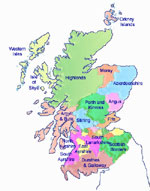
 Kenmore
is an extremely attractive planned village situated some 6 miles west
of Aberfeldy on the A827. Its site is on what amounts to a promontory
projecting into the eastern end of Loch Tay, and it has the loch to its
south and west, and the River Tay to its north.
Kenmore
is an extremely attractive planned village situated some 6 miles west
of Aberfeldy on the A827. Its site is on what amounts to a promontory
projecting into the eastern end of Loch Tay, and it has the loch to its
south and west, and the River Tay to its north.





